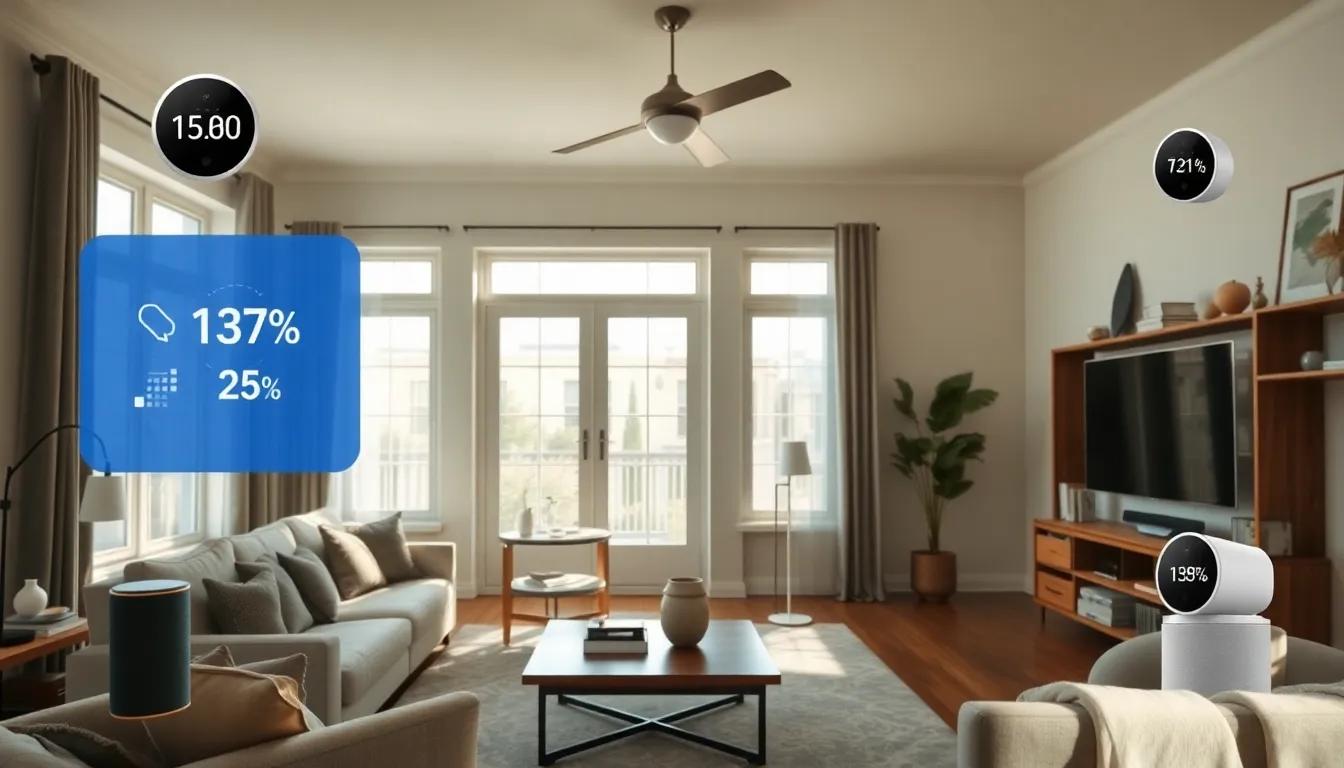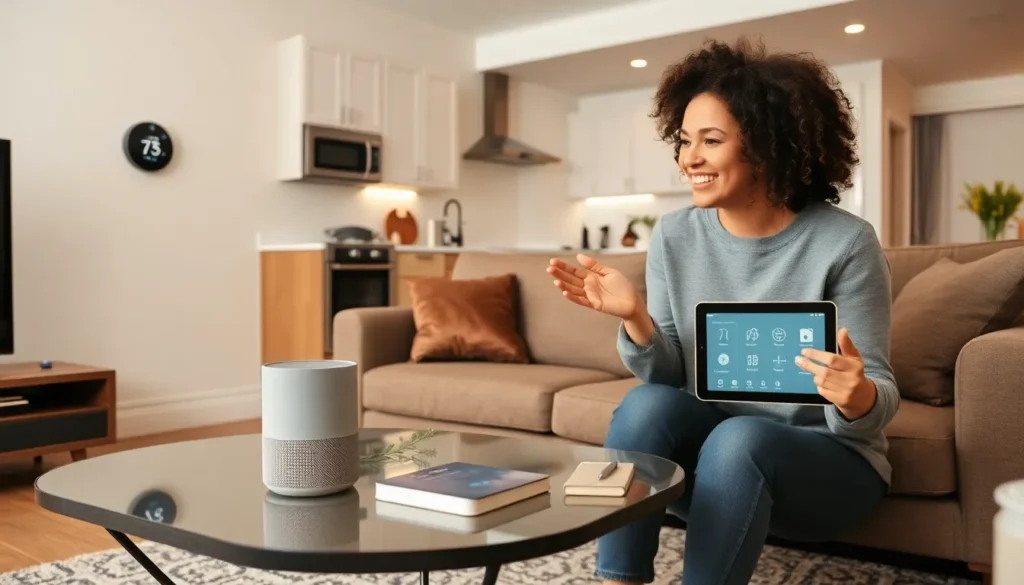Imagine a world where your home does the heavy lifting while you kick back with a snack. Smart home technology is turning that dream into reality, transforming ordinary houses into futuristic havens of convenience. From voice-activated assistants that know your coffee preferences to security systems that can outsmart even the craftiest of burglars, these gadgets are here to make life easier, one automated task at a time.
Table of Contents
ToggleOverview of Smart Home Technology
Smart home technology encompasses devices and systems that enhance the convenience and efficiency of daily living. Automation allows users to control lighting, heating, entertainment, and security remotely. These innovations typically integrate with a central hub or a smartphone app, enabling streamlined management.
A significant component involves voice-activated assistants. These virtual aids, such as Amazon Alexa and Google Assistant, fulfill user commands through simple voice interactions. Personal preference recognition allows for tailored experiences, learning user habits over time.
Security systems represent another critical aspect. Smart cameras and doorbells provide real-time video feeds, offering insights into home activities. Alerts notify homeowners of unusual events, enhancing safety measures.
Energy management devices have gained traction as well. Smart thermostats, such as the Nest Learning Thermostat, adjust heating and cooling based on user behavior. This leads to reduced energy consumption and cost savings.
Furthermore, smart appliances play a vital role in creating a connected environment. Refrigerators, ovens, and laundry machines now feature internet connectivity, allowing for remote monitoring and control. This capability helps in meal preparation and inventory management.
Homeowners increasingly embrace these technologies for improved quality of life. Adopting smart home products promotes efficiency, security, and sustainability. Comprehensive systems can interconnect various devices, creating a seamless smart living experience.
Key Components of Smart Home Technology

Smart home technology integrates various components that enhance convenience and efficiency. Understanding these elements is essential for maximizing benefits in everyday living.
Smart Devices
Smart devices form the backbone of any smart home setup. Common examples include smart speakers like Amazon Echo and Google Nest Hub. They facilitate voice commands for tasks such as adjusting lighting and controlling temperature. Smart thermostats like Nest or Ecobee optimize energy use by learning user habits, contributing to cost savings. Smart cameras and doorbells enhance security by providing real-time monitoring and alerts. Each device communicates effectively, creating a seamless user experience. Remote access through smartphone apps allows individuals to monitor and control these devices from anywhere.
Connectivity
Connectivity underpins smart home technology, ensuring devices work together efficiently. Wi-Fi or Zigbee networks typically support this interconnectedness. Home automation systems leverage protocols like Z-Wave or Bluetooth to enable smooth communication between devices. A central hub often manages these connections, allowing users to customize and automate functions easily. It’s important to ensure robust security measures are in place to protect the network from unauthorized access. Strong connectivity facilitates integration with platforms like IFTTT and voice assistants, enhancing the overall functionality. Effective connectivity strengthens the smart home ecosystem, driving user convenience and satisfaction.
Benefits of Smart Home Technology
Smart home technology offers numerous benefits that enhance daily life. Users experience remarkable convenience through automation.
Convenience and Automation
Automation simplifies tasks around the house. Smart lights can adjust based on user schedules, turning on or off automatically. Voice assistants facilitate hands-free control, allowing users to manage various devices with ease. Smart thermostats adapt heating and cooling preferences, optimizing comfort throughout the day. Additionally, users can monitor their homes remotely. This flexibility allows for modifications even when away. Smart appliances, like refrigerators, can notify users of expiration dates, reducing food waste. Overall, these conveniences streamline household activities, making life notably easier.
Security Enhancements
Enhanced security represents a significant advantage of smart home technology. Smart cameras provide real-time surveillance, delivering alerts directly to users’ smartphones. Doorbell cameras enable users to see who’s at their door without opening it. Home security systems often include motion detectors that notify owners of unusual activity. Furthermore, remote access allows users to control locks, ensuring their homes remain secure regardless of their location. Users can even receive security updates via smartphone apps. These features create a safer environment, bolstering peace of mind and protection.
Challenges and Considerations
Smart home technology brings several challenges that require attention. Users must consider potential privacy issues alongside other factors.
Privacy Issues
Device data collection raises significant privacy concerns. Many smart devices gather personal information, including usage patterns and preferences. Vulnerabilities in these devices can lead to unauthorized access, compromising user privacy. Users often overlook privacy policies, which may be complex and unclear. Awareness of data sharing practices becomes crucial. Ensuring devices follow stringent security standards can mitigate risks associated with privacy breaches. Regular software updates help patch vulnerabilities, providing additional protection against threats.
Compatibility and Integration
Ensuring compatibility poses a challenge for smart home technology. Various manufacturers create devices that don’t always work together seamlessly. Integration challenges often arise when connecting devices from different brands. Users may experience frustrations finding a central hub that accommodates all their smart appliances and systems. Adopting standardized protocols like Zigbee or Z-Wave simplifies integration efforts. Comprehensive research on device compatibility before purchasing can lead to a more cohesive smart home ecosystem. Prioritizing compatibility enhances user experience and maximizes the benefits of smart technology.
Future Trends in Smart Home Technology
Integration of artificial intelligence drives future developments in smart home technology. AI will enhance automation, making devices more intuitive and user-friendly. Voice recognition capabilities will see significant improvement, allowing for more natural interactions.
Expansion of IoT (Internet of Things) will connect an increasing number of devices. This connectivity fosters a seamless smart home experience. Enhanced interoperability among devices from different manufacturers is likely, simplifying user management.
Sustainability emerges as a major focus in smart technology. Eco-friendly devices and energy-efficient appliances will reduce environmental footprints. Smart home systems will monitor energy use, promoting cost savings through optimized resource consumption.
Increased focus on security will also shape new advancements. Smart devices will come equipped with sophisticated encryption and secure authentication features. Users can expect real-time threat detection and alerts from integrated security systems.
User privacy remains a top concern as well. Manufacturers will need to prioritize transparency regarding data collection and sharing practices. Adoption of strict privacy standards will enhance trust and encourage further smart home adoption.
Customization options will become more widespread, allowing personalized settings for individual preferences. Improved machine learning algorithms will adapt to user habits, enhancing overall convenience. Devices will learn and predict user needs, streamlining everyday tasks.
Finally, voice-activated technology is set for further growth, moving beyond basic commands. Users can expect smarter interactions with devices, making technology even more accessible. Future trends in smart home technology promise an all-encompassing, user-friendly experience, significantly transforming daily living.
Smart home technology is reshaping how individuals interact with their living spaces. By automating tasks and enhancing convenience, it offers a level of efficiency previously unimaginable. As innovations continue to emerge, users can expect even greater integration and smarter solutions tailored to their needs.
While challenges like privacy concerns and device compatibility exist, the benefits far outweigh the drawbacks. With a focus on sustainability and security, the future of smart homes looks promising. Embracing these advancements not only improves daily living but also sets the stage for a more connected and efficient lifestyle. The journey into smart home technology is just beginning, and its potential is boundless.

